Novel Mutant Phospholipase D from Hemiscorpius lepturus Acts as A Highly Immunogen in BALB/c Mice Against the Lethality of Scorpion Venom
Abstract
1. Introduction
2. Results
2.1. Protein Structure Analysis
2.2. Circular Dichroism
2.3. Fluorescence Spectroscopy
2.4. SDS-PAGE
2.5. TNPAL-SM Hydrolysis
2.6. Non-Lethality Assay of Mut-rPLD1
2.7. Non-Dermonecrotic Test of Mut-rPLD1
2.8. Vaccination Trials in the Mice
2.9. ELISA Test
2.10. Ouchterlony Test
2.11. Western Blotting
2.12. Effect of Antigens on Splenocytes Proliferation
3. Discussion
4. Materials and Methods
4.1. Protein Structure Prediction
4.2. Circular Dichroism Spectroscopy (CD)
4.3. Fluorescence Spectroscopy
4.4. Cloning and Expression of Mut-rPLD1
4.5. Purification of Mut-rPLD1
4.6. SDS-PAGE Analysis for Assessing Proteins
4.7. In Vitro Sphingomyelin Hydrolysis Activity Assay of Mut-rPLD1
4.8. Non-Lethality Test of Mut-rPLD1 in the Mice
4.9. Non-Dermonecrotic Test of Mut-rPLD1 on Rabbit Skin
4.10. Immunization of the Mice by Mut-rPLD1
4.10.1. Immunization by Toxoid-Freund’s Adjuvant
4.10.2. Immunization by Toxoid-Alum Adjuvant
4.11. Indirect ELISA for Detection of Raised Antibody in Immunized Mice
4.12. Double-Immunodiffusion Assay (Ouchterlony Test)
4.13. Western Blotting Assay
4.14. Splenocytes Proliferation Assay
4.15. Challenging Tests in Immunized Mice
4.16. Statistical Analysis
5. Conclusion
Author Contributions
Funding
Acknowledgments
Conflicts of Interest
Ethical Statement
References
- Dehghani, R.; valaie, N. The review of status of scorpion sting in Iran and problems from it. Feyz 2005, 9, 73–92. [Google Scholar]
- Dehghani, R.; Kamiabi, F.; Mohammadi, M. Scorpionism by Hemiscorpius spp. in Iran: A review. J. Venom. Anim. Toxins Incl. Trop. Dis. 2018, 24, 8. [Google Scholar]
- Shahbazzadeh, D.; Srairi-Abid, N.; Feng, W.; Ram, N.; Borchani, L.; Ronjat, M.; Akbari, A.; Pessah, I.N.; De Waard, M.; El Ayeb, M. Hemicalcin, a new toxin from the Iranian scorpion Hemiscorpius lepturus which is active on ryanodine-sensitive Ca2+ channels. Biochem. J. 2007, 404, 89–96. [Google Scholar] [CrossRef]
- Latifi, M.; Tabatabai, M. Immunological studies on Iranian scorpion venom and antiserum. Toxicon 1979, 17, 617–621. [Google Scholar] [CrossRef]
- Bawaskar, H.S.; Bawaskar, P.H. Scorpion sting: Update. J. Assoc. Physicians India. 2012, 60, 46–55. [Google Scholar]
- Pipelzadeh, M.H.; Jalali, A.; Taraz, M.; Pourabbas, R.; Zaremirakabadi, A. An epidemiological and a clinical study on scorpionism by the Iranian scorpion Hemiscorpius lepturus. Toxicon 2007, 50, 984–992. [Google Scholar] [CrossRef]
- Srairi-Abid, N.; Shahbazzadeh, D.; Chatt, I.; Mlayah-Bellalouna, S.; Mejdoub, H.; Borchani, L.; Benkhalifa, R.; Akbari, A.; El Ayeb, M. Hemitoxin, the first potassium channel toxin from the venom of the Iranian scorpion Hemiscorpius lepturus. FEBS J. 2008, 275, 4641–4650. [Google Scholar] [CrossRef]
- Kazemi-Lomedasht, F.; Khalaj, V.; Bagheri, K.P.; Behdani, M.; Shahbazzadeh, D. The first report on transcriptome analysis of the venom gland of Iranian scorpion, Hemiscorpius lepturus. Toxicon 2017, 125, 123–130. [Google Scholar] [CrossRef]
- Radmanesh, M. Cutaneous manifestations of the Hemiscorpius lepturus sting: A clinical study. Int. Dermatol. J. 1998, 37, 500–507. [Google Scholar] [CrossRef]
- Vazirianzadeh, B.; Farhadpour, F.; Hosseinzadeh, M.; Zarean, M.; Moravvej, S. An epidemiological and clinical study on scorpionism in hospitalized children in khuzestan, iran. J. Arthropod Borne Dis. 2012, 6, 62–69. [Google Scholar]
- Seyedian, R.; Jalali, A.; Babaee, M.H.; Pipelzadeh, M.H.; Rezaee, S.A. Biodistribution study of Hemiscorpius lepturus scorpion venom and available polyclonal antivenom in rats. J. Venom. Anim. Toxins Incl. Trop. Dis. 2012, 18, 375–383. [Google Scholar] [CrossRef]
- Vazirianzadeh, A.; Hossienzadeh, B.; Moravvej, M.; Vazirianzadeh, S.A.; Mosavi, S.G. An Epidemiological Study on Scorpion Stings in Lordegan County, South-west of Iran. Arch. de L’Institut Razi. 2013, 68, 71–76. [Google Scholar]
- Valavi, E.; Alemzadeh Ansari, M.J. Hemolytic uremic syndrome following Hemiscorpius lepturus (scorpion) sting. Indian J. Nephrol. 2008, 18, 166–168. [Google Scholar] [CrossRef] [PubMed]
- Jalali, A.; Pipelzadeh, M.H.; Sayedian, R.; Rowan, E.G. A review of epidemiological, clinical and in vitro physiological studies of envenomation by the scorpion Hemiscorpius lepturus (Hemiscorpiidae) in Iran. Toxicon 2010, 55, 173–179. [Google Scholar] [CrossRef]
- Pipelzadeh, M.H.; Dezfulian, A.R.; Jalali, M.T.; Mansori, A.K. In vitro and in vivo studies on some toxic effects of the venom from Hemiscorpious lepturus scorpion. Toxicon 2006, 48, 93–103. [Google Scholar] [CrossRef]
- Da Silva, P.H.; da Silveira, R.B.; Appel, M.H.; Mangili, O.C.; Gremski, W. Brown spiders and loxoscelism. Toxicon 2004, 44, 693–709. [Google Scholar] [CrossRef]
- Borchani, L.; Sassi, A.; Shahbazzadeh, D.; Strub, J.M.; Tounsi-Guetteti, H.; Boubaker, M.S.; Akbari, A.; Van Dorsselaer, A.; El Ayeb, M. Heminecrolysin, the first hemolytic dermonecrotic toxin purified from scorpion venom. Toxicon 2011, 58, 130–139. [Google Scholar] [CrossRef]
- Borchani, L.; Sassi, A.; Yekhlef, R.B.; Safra, I.; El Ayeb, M. Heminecrolysin, a potential immunogen for monospecific antivenom production against Hemiscorpius lepturus scorpion. Toxicon 2011, 58, 681–688. [Google Scholar] [CrossRef]
- Torabi, E.; Shahbazzadeh, D.; Pooshang Bagheri, K.; Behdani, M.; Khalaj, V.; Hosseininejad Chafi, M.; Moazzami, R.; Sabatier, J.M. Characteristics and lethality of a novel recombinant dermonecrotic venom phospholipase D from Hemiscorpius lepturus. Toxins 2017, 9, 102. [Google Scholar] [CrossRef]
- Futrell, J. Loxoscelism. Am. J. Med. Sci. 1992, 304, 261–267. [Google Scholar] [CrossRef]
- Da Silveira, R.B.; Pigozzo, R.B.; Chaim, O.M.; Appel, M.H.; Silva, D.T.; Dreyfuss, J.L.; Toma, L.; Dietrich, C.P.; Nader, H.B.; Veiga, S.S.; et al. Two novel dermonecrotic toxins LiRecDT4 and LiRecDT5 from brown spider (Loxosceles intermedia) venom: From cloning to functional characterization. Biochimie 2007, 89, 289–300. [Google Scholar] [CrossRef] [PubMed]
- Chaim, O.M.; Sade, Y.B.; Da Silveira, R.B.; Toma, L.; Kalapothakis, E.; Chávez-Olórtegui, C.; Mangili, O.C.; Gremski, W.; Von Dietrich, C.P.; Nader, H.B.; et al. Brown spider dermonecrotic toxin directly induces nephrotoxicity. Toxicol. Appl. Pharm. 2006, 211, 64–67. [Google Scholar] [CrossRef] [PubMed]
- Da Silveira, R.B.; Pigozzo, R.B.; Chaim, O.M.; Appel, M.H.; Dreyfuss, J.L.; Toma, L.; Mangili, O.C.; Gremski, W.; Von Dietrich, C.P.; Nader, H.B.; et al. Molecular cloning and functional characterization of two isoforms of dermonecrotic toxin from Loxosceles intermedia (brown spider) venom gland. Biochimie 2006, 88, 1241–1253. [Google Scholar] [CrossRef] [PubMed]
- Moolenaar, W.H.; van Meeteren, L.A.; Giepmans, B.N. The ins and outs of lysophosphatidic acid signaling. BioEssays 2004, 26, 870–881. [Google Scholar] [CrossRef]
- Corda, D.; Iurisci, C.; Berrie, C.P. Biological activities and metabolism of the lysophosphoinositides and glycerophosphoinositols. Biochim. Biophys. Acta. 2002, 1582, 52–69. [Google Scholar] [CrossRef]
- Lee, S.; Lynch, K.R. Brown recluse spider (Loxosceles reclusa) venom phospholipase D (PLD) generates lysophosphatidic acid (LPA). Biochem. J. 2005, 391, 317–323. [Google Scholar] [CrossRef]
- Lajoie, D.M.; Zobel-Thropp, P.A.; Kumirov, V.K.; Bandarian, V.; Binford, G.J.; Cordes, M.H. Phospholipase D Toxins of Brown Spider Venom Convert Lysophosphatidylcholine and Sphingomyelin to Cyclic Phosphates. PLoS ONE 2013, 8, e72372. [Google Scholar] [CrossRef]
- Dehghani, R.; Fathi, B. Scorpion sting in Iran: A review. Toxicon 2012, 60, 919–933. [Google Scholar] [CrossRef]
- Tambourgi, D.V.; Goncalves-de-Andrade, R.M.; van den Berg, C.W. Loxoscelism: From basic research to the proposal of new therapies. Toxicon 2010, 56, 1113–1119. [Google Scholar] [CrossRef]
- Appel, M.H.; da Silveira, R.B.; Chaim, O.M.; Paludo, K.S.; Silva, D.T.; Chaves, D.M.; da Silva, P.H.; Mangili, O.C.; Senff-Ribeiro, A.; Gremski, W.; et al. Identification, cloning and functional characterization of a novel dermonecrotic toxin (phospholipase D) from brown spider (Loxosceles intermedia) venom. Biochim. Biophys. Acta. 2008, 1780, 167–178. [Google Scholar] [CrossRef]
- Yang, J.; Yan, R.; Roy, A.; Xu, D.; Poisson, J.; Zhang, Y. The I-TASSER Suit: Protein structure and function prediction. Nat. methods. 2015, 12, 7–8. [Google Scholar] [CrossRef] [PubMed]
- Vuitika, L.; Chaves-Moreira, D.; Caruso, I.; Lima, M.A.; Matsubara, F.H.; Murakami, M.T.; Takahashi, H.K.; Toledo, M.S.; Coronado, M.A.; Nader, H.B.; et al. Active site mapping of Loxosceles phospholipases D: Biochemical and biological features. Biochim. Biophys Acta. 2016, 1861, 970–979. [Google Scholar] [CrossRef] [PubMed]
- Safari Foroushani, N.; Modarressi, M.H.; Behdani, M.; Torabi, E.; Pooshang Bagheri, K.; Shahbazzadeh, D. Developing recombinant phospholipase D1 (rPLD1) toxoid from Iranian Hemiscorpius lepturus scorpion and its protective effects in BALB/c mice. Toxicon 2018, 152, 30–36. [Google Scholar] [CrossRef] [PubMed]
- Kalapothakis, E.; Chatzaki, M.; Goncalves-Dornelas, H.; De Castro, C.S.; Silvestre, F.G.; Laborne, F.V.; De Moura, J.F.; Veiga, S.S.; Chavez-Olortegui, C.; Granier, C.; et al. The Loxtox protein family in Loxosceles intermedia (Mello-Leitao) venom. Toxicon 2007, 50, 938–946. [Google Scholar] [CrossRef] [PubMed]
- Vermilyea, B.L.; Walker, H.W.; Ayres, J.C. Detection of Botulinal Toxins by Immunodiffusion. Appl Microbiol. 1968, 16, 21–24. [Google Scholar] [CrossRef] [PubMed]
- Heidarpour, M.; Ennaifer, E.; Ahari, H.; Srairi-Abid, N.; Borchani, L.; Khalili, G.; Amini, H.; Anvar, A.A.; Boubaker, S.; El-Ayeb, M.; et al. Histopathological changes induced by Hemiscorpius lepturus scorpion venom in mice. Toxicon 2012, 59, 373–378. [Google Scholar] [CrossRef]
- Hmila, I.; Saerens, D.; Benlasfar, Z.; Conrath, K.; El Ayeb, M.; Muyldermans, S.; Bouhaouala-Zahar, B. VHH, bivalent domains and chimeric heavy chain-only antibodies with high neutralizing efficacy for scorpion toxin AahI0. Mol. Immunol. 2008, 45, 3847–3856. [Google Scholar] [CrossRef]
- Abderrazek, R.B.; Vincke, C.; Hmila, I.; Saerens, D.; Abidi, N.; ElAyeb, M.; Muyldermans, S.; Bouhaouala-Zahar, B. Development of Cys38 knock-out and humanized version of NbAahII10 nanobody with improved neutralization of AahII scorpion toxin. Protein Eng. Des. Sel. 2011, 24, 727–735. [Google Scholar] [CrossRef]
- Sambrook, J.; Russell, D.W. Molecular Cloning: A Laboratory Manual, 3rd ed.; Cold Spring Harbor Laboratory Press: Cold Spring Harbor, NY, USA, 2001. [Google Scholar]
- Laemmli, U.K. Cleavage of structural proteins during the assembly of the head of bacteriophage T4. Nature 1970, 227, 680–685. [Google Scholar] [CrossRef]
- Ouchterlony, O.; Nilsson, L.A. Immunodiffusion and immunoelectrophoresis. In Handbook of Experimental Immunology, 4th ed.; Weir, D.M., Herzerberg, L.A., Blackwell, C., Herzerberg, L.A., Eds.; Blackwell: Oxford, UK; Volume 1, pp. 32.1–32.50.
Sample Availability: Available from the authors. |

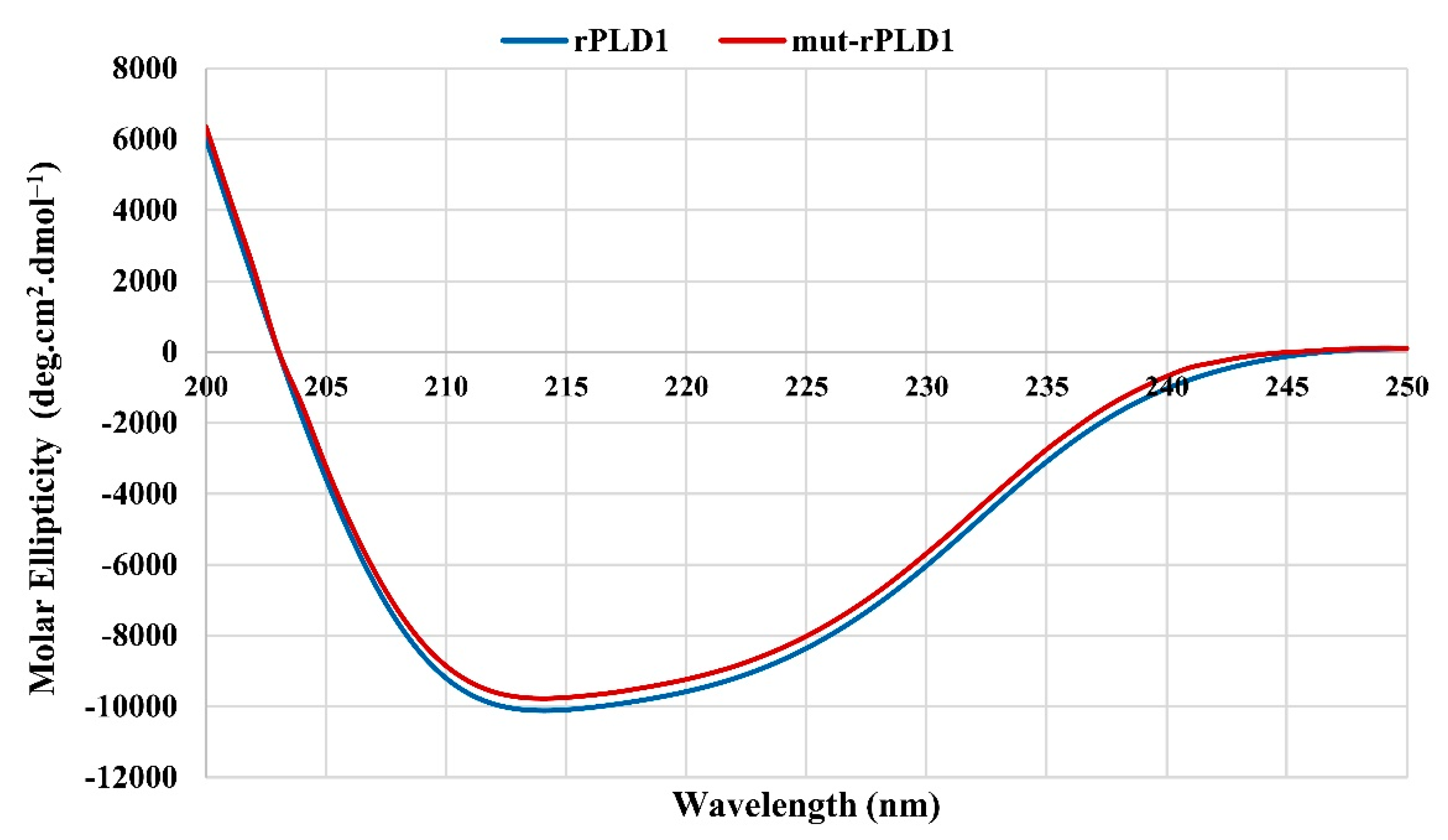
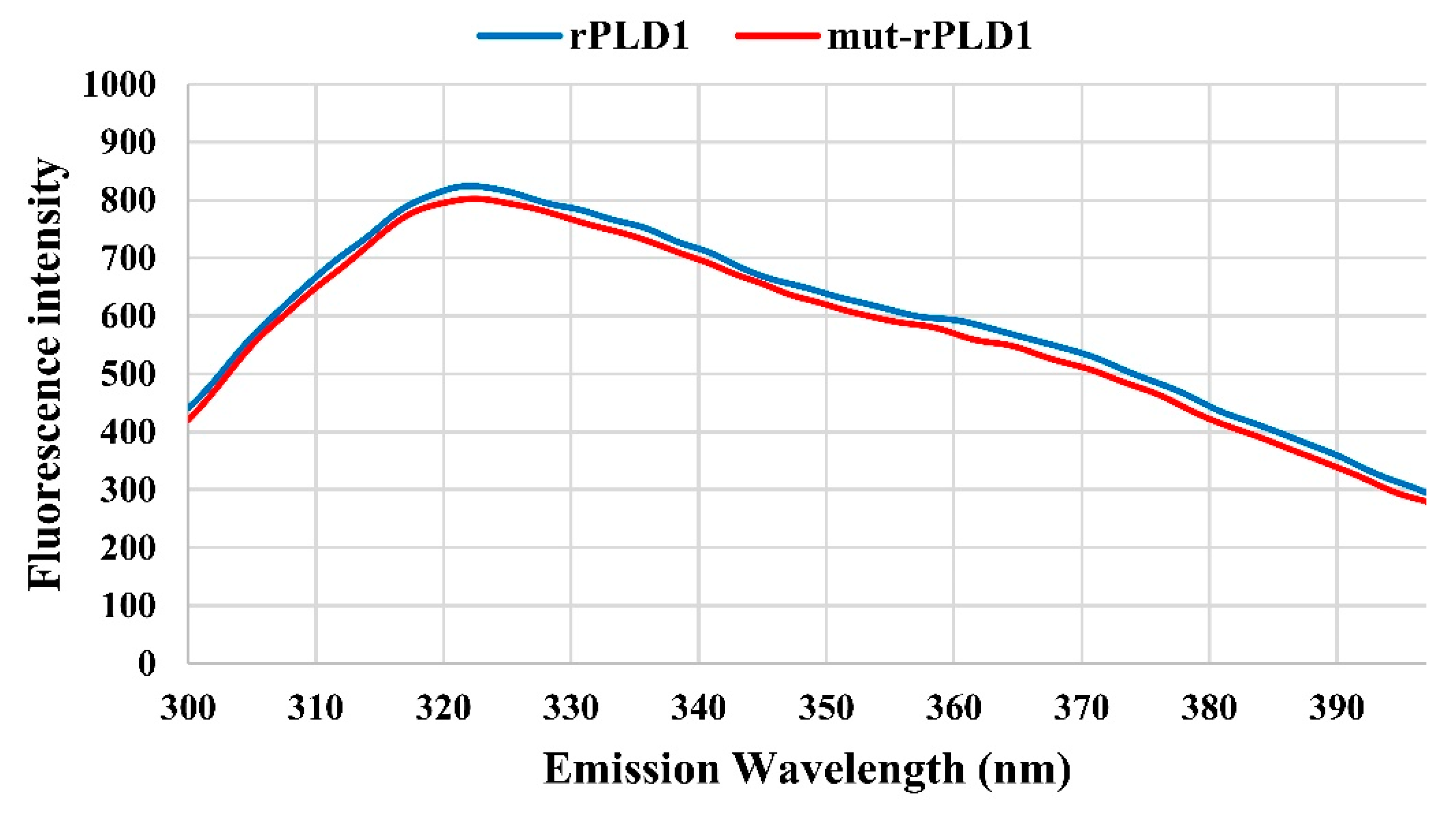
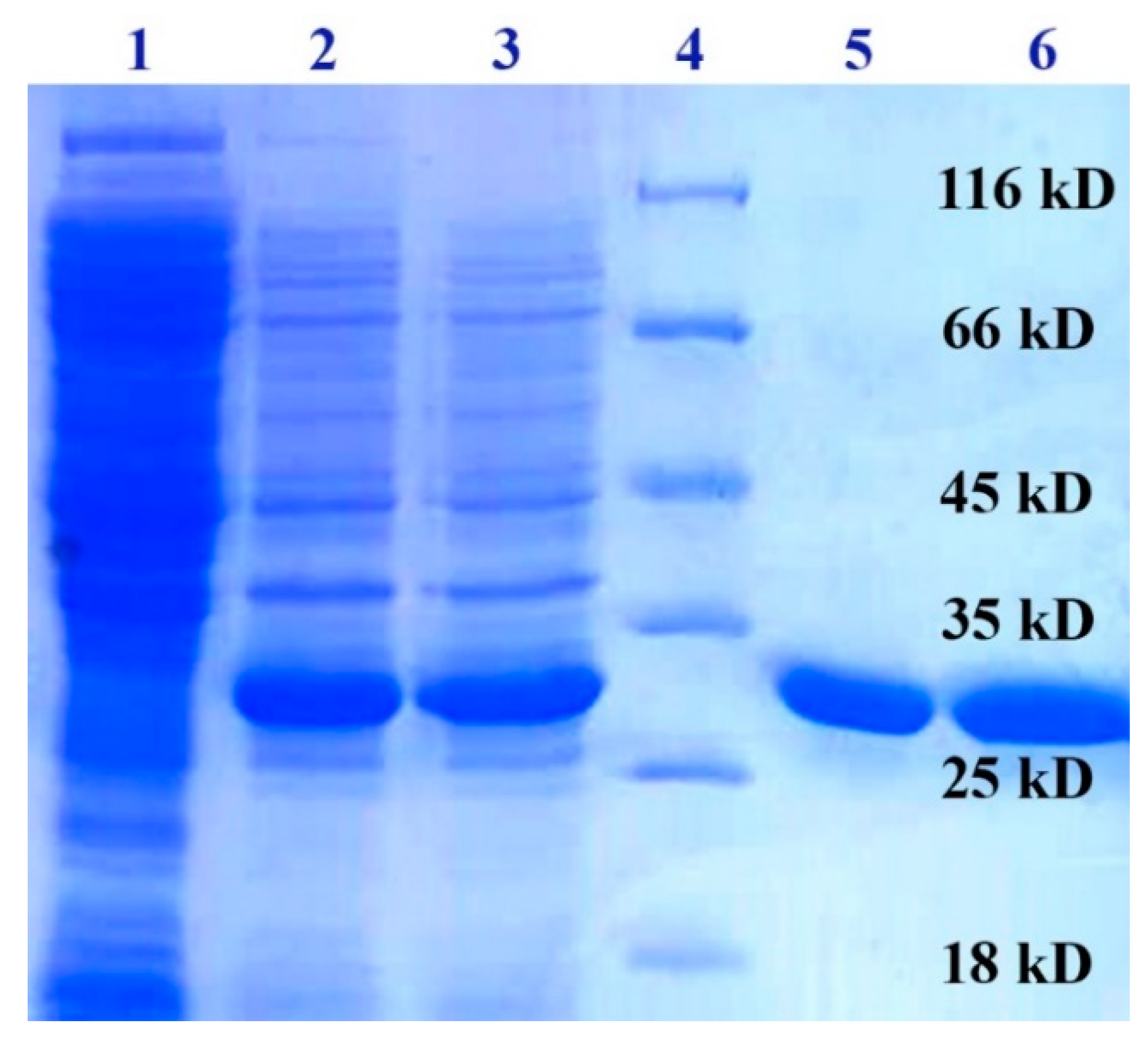
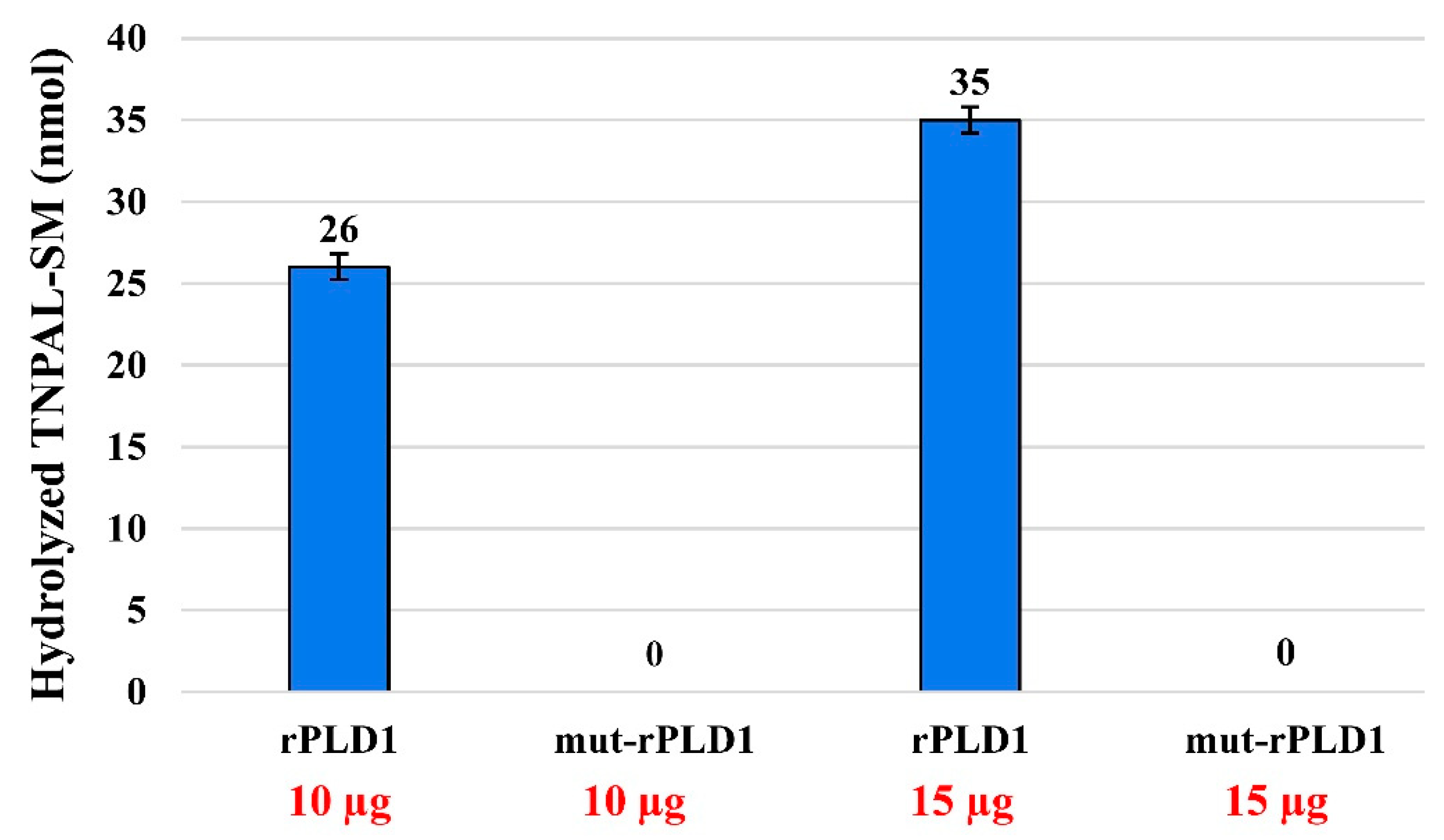
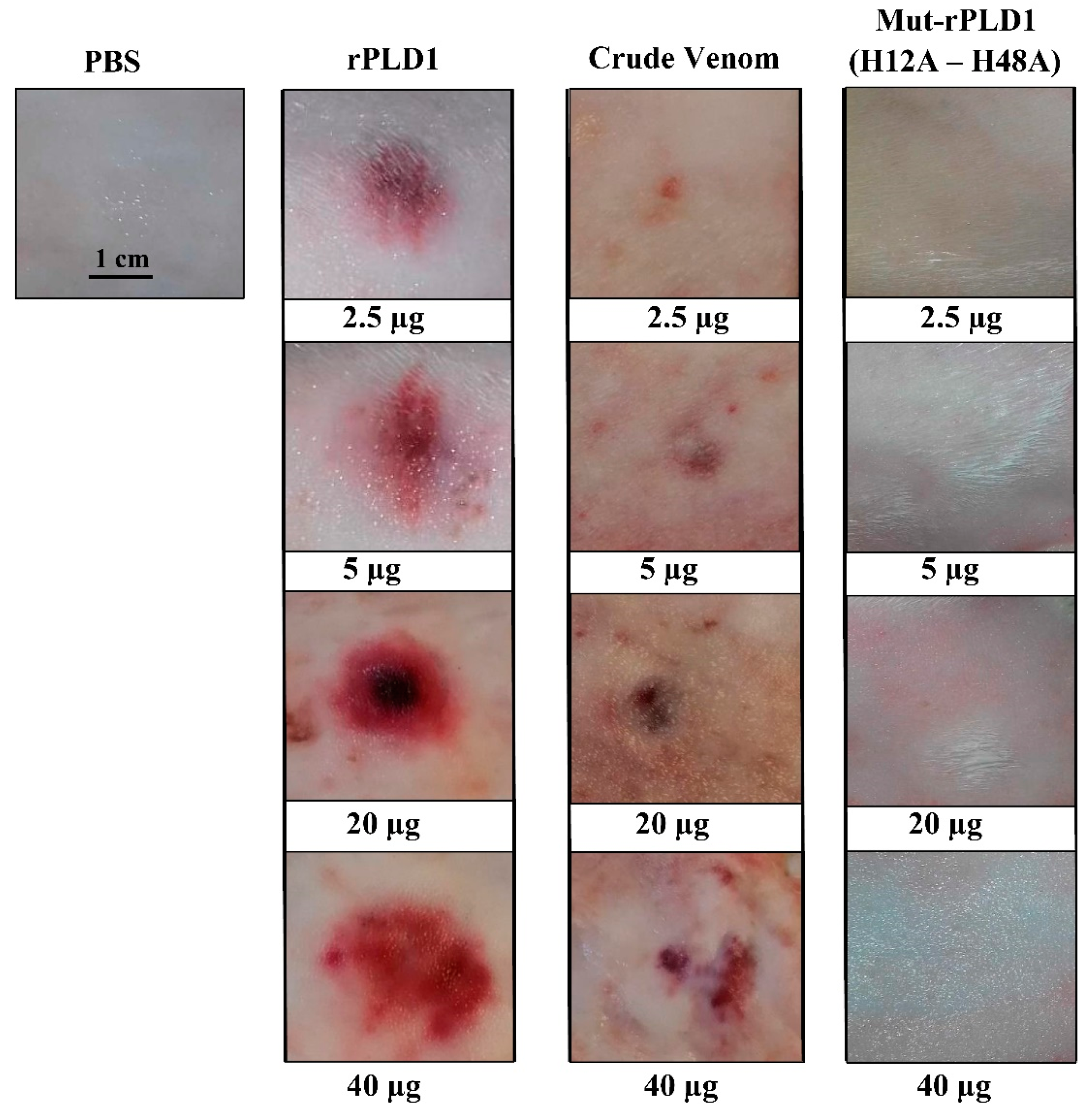
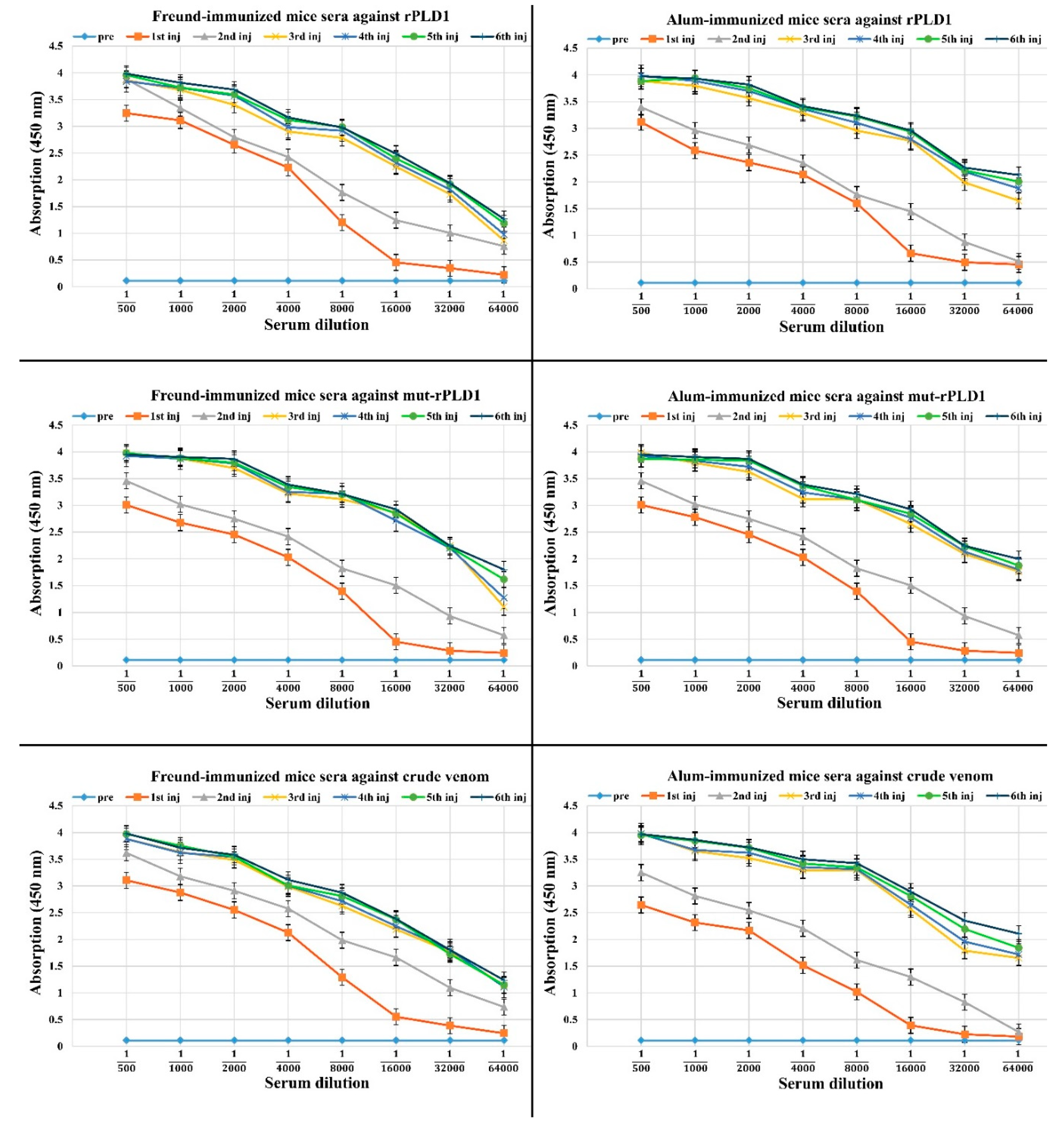

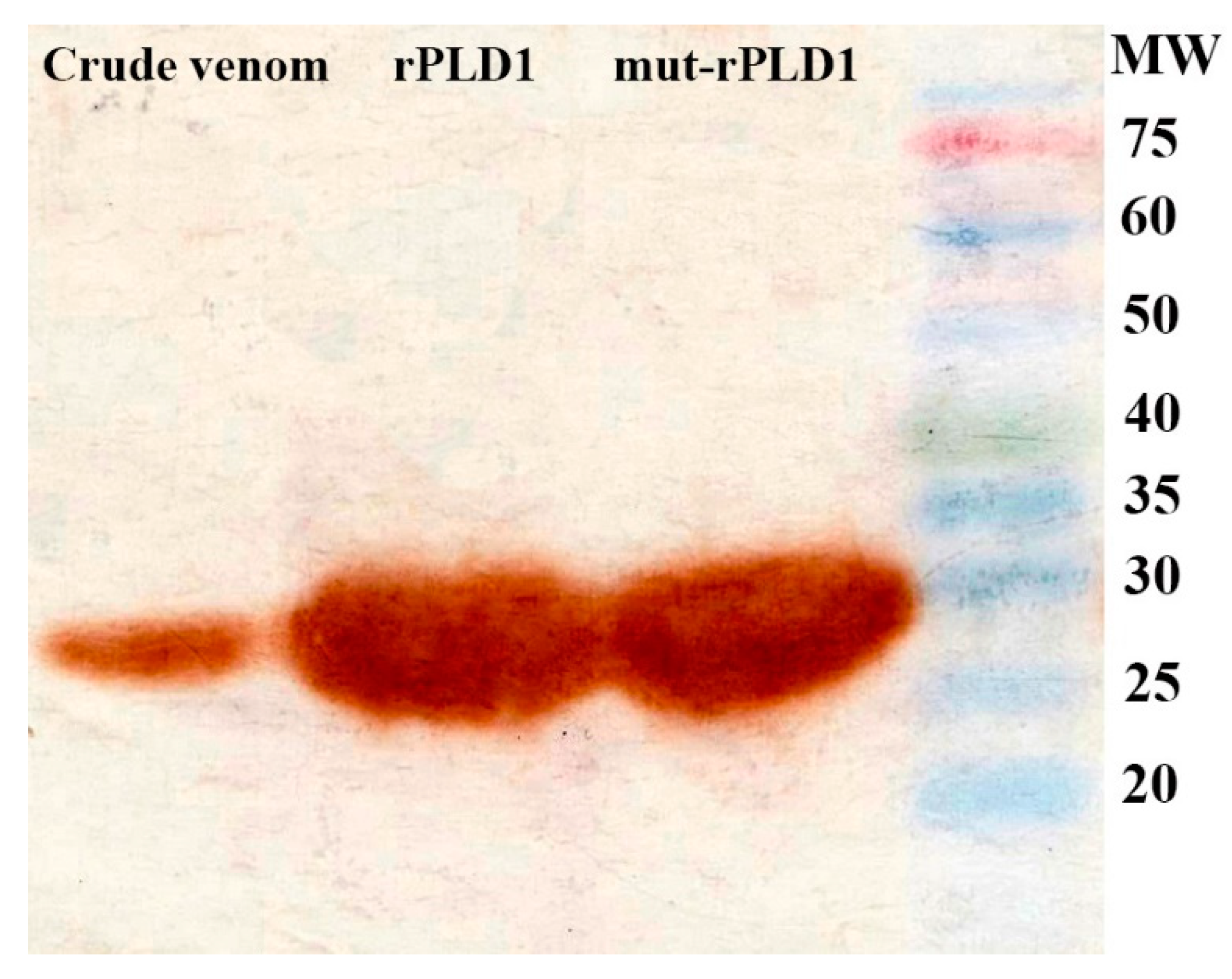
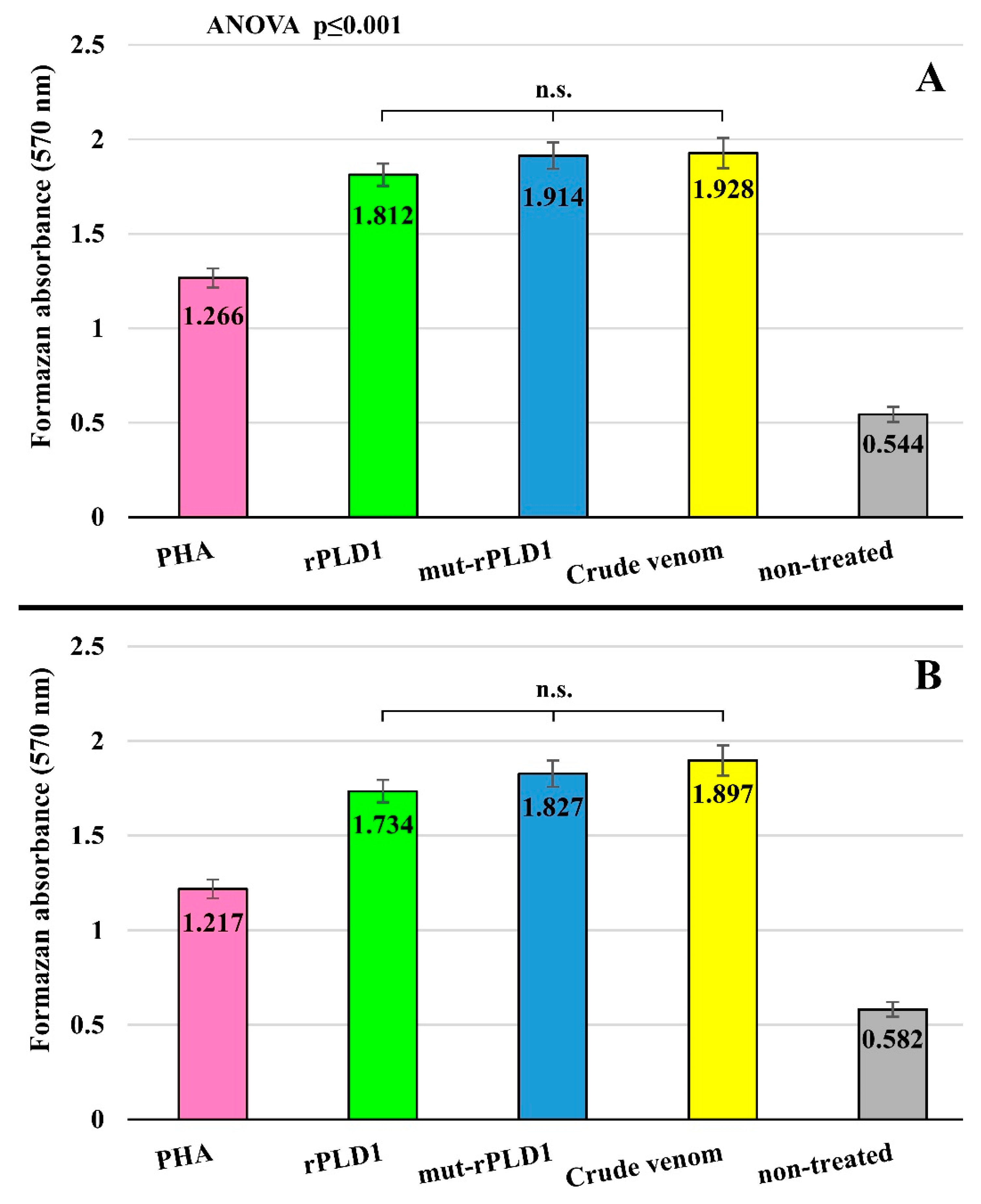
| Groups | Number of Mice | Mut-rPLD1 (µg) | Survival Rate |
|---|---|---|---|
| 1 | 5 | 3.7 | 5/5 |
| 2 | 5 | 18.5 | 5/5 |
| 3 | 5 | 37 | 5/5 |
| 4 | 5 | 111 | 5/5 |
| rPLD1 (µg) | |||
| Negative control | 5 | 3.7 | 0/5 |
| Mice Vaccinated by Mut-rPLD1-Freund/Alum Adjuvant | |||||||
|---|---|---|---|---|---|---|---|
| Number of Mice | rPLD1 Challenge (LD100s)(a) | Survival Rate | Number of Mice | Crude Venom Challenge (LD100s)(b) | Survival Rate | ||
| 6 | 10 | 6/6 | 6 | 1 | 6/6 | ||
| 6 | 20 | 6/6 | 6 | 2 | 6/6 | ||
| 6 | 50 | 6/6 | 6 | 5 | 6/6 | ||
| 6 | 100 | 6/6 | 6 | 7 | 6/6 | ||
| 6 | 200 | 6/6 | 6 | 10 | 6/6 | ||
| Neg cont(c) | 1 | 0/6 | Neg cont(c) | 1 | 0/6 | ||
| 6 | 6 | ||||||
© 2020 by the authors. Licensee MDPI, Basel, Switzerland. This article is an open access article distributed under the terms and conditions of the Creative Commons Attribution (CC BY) license (http://creativecommons.org/licenses/by/4.0/).
Share and Cite
Soleimani Moez, A.; H. Sajedi, R.; Pooshang Bagheri, K.; Sabatier, J.-M.; Shahbazzadeh, D. Novel Mutant Phospholipase D from Hemiscorpius lepturus Acts as A Highly Immunogen in BALB/c Mice Against the Lethality of Scorpion Venom. Molecules 2020, 25, 1673. https://doi.org/10.3390/molecules25071673
Soleimani Moez A, H. Sajedi R, Pooshang Bagheri K, Sabatier J-M, Shahbazzadeh D. Novel Mutant Phospholipase D from Hemiscorpius lepturus Acts as A Highly Immunogen in BALB/c Mice Against the Lethality of Scorpion Venom. Molecules. 2020; 25(7):1673. https://doi.org/10.3390/molecules25071673
Chicago/Turabian StyleSoleimani Moez, Abouzar, Reza H. Sajedi, Kamran Pooshang Bagheri, Jean-Marc Sabatier, and Delavar Shahbazzadeh. 2020. "Novel Mutant Phospholipase D from Hemiscorpius lepturus Acts as A Highly Immunogen in BALB/c Mice Against the Lethality of Scorpion Venom" Molecules 25, no. 7: 1673. https://doi.org/10.3390/molecules25071673
APA StyleSoleimani Moez, A., H. Sajedi, R., Pooshang Bagheri, K., Sabatier, J.-M., & Shahbazzadeh, D. (2020). Novel Mutant Phospholipase D from Hemiscorpius lepturus Acts as A Highly Immunogen in BALB/c Mice Against the Lethality of Scorpion Venom. Molecules, 25(7), 1673. https://doi.org/10.3390/molecules25071673







